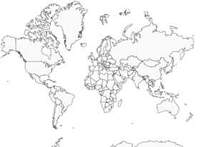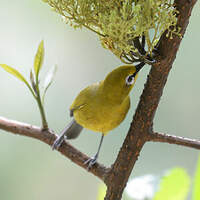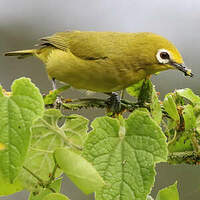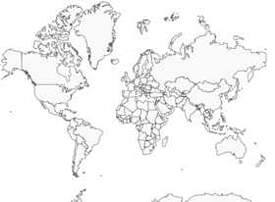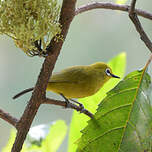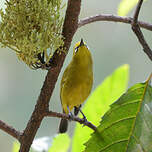Northern Yellow White-eye
Zosterops senegalensis - Zostérops jaune
Identification
The Northern Yellow White-eye is the only species of white-eye present in most of its distribution range, particularly in West Africa. And as it is a characteristic bird, its identification theoretically poses no problems.
The Northern Yellow White-eye lives up to its name because it is very yellow in appearance. There is no sexual dimorphism. In the adult, the upper parts are a very nuanced olive-green with yellow while the lower parts are bright yellow. The remiges, the wing covers and the rectrices are dark brown, but largely trimmed with yellow-green, which makes most of the wings and tail the same colour as the rest of the body. The head is very yellow, particularly the face, with the vertex being slightly tinted green. Characteristic of the genus, the eye is surrounded by a white eye ring of 1 to 2 mm wide. The iris is brown-honey. A thin black loral line goes from the beak to the eye ring. The black tends to darken the circle when in contact with it and to go around it under it. The beak, thin and slightly curved, is black, more or less bluish-grey at the base. The legs are black.
The immature resembles the adult with paler lower parts.
There are 7 subspecies which differ from each other only by small details, size, nuances of plumage colouration, width of the eye ring, etc. For example, the subspecies jacksoni from Kenya and Tanzania has a noticeably wider eye ring.
Subspecific information 4 subspecies
- Zosterops senegalensis senegalensis (Mauritania and Senegal to nw Ethiopia)
- Zosterops senegalensis jacksoni (w Kenya and n Tanzania)
- Zosterops senegalensis demeryi (Sierra Leone, Liberia and Ivory Coast)
- Zosterops senegalensis gerhardi (s Sudan and ne Uganda)
Foreign names
- Zostérops jaune,
- Anteojitos senegalés,
- olho-branco-amarelo-do-norte,
- Senegalbrillenvogel,
- szenegáli pápaszemesmadár,
- Noordelijke Afrikaanse Brilvogel,
- Occhialino africano,
- afrikansk glasögonfågel,
- Gulbrillefugl,
- okánik kanáričí,
- kruhoočko žlutozelené,
- Gul Brillefugl,
- afrikankeltarilli,
- Geelglasogie (Geelkersogie),
- zostèrops africà,
- szlarnik senegalski,
- Сенегальская белоглазка,
- キイロメジロ,
- 黄绣眼鸟,
- afrikansk glasögonfågel,
- 非洲黃繡眼,
Voice song and call
The Northern Yellow White-eye sings mainly in the morning, very early at dawn and shortly after sunrise, from the top of a tall forest tree. It follows a series of 12 to 30 notes before making a pause to start again: tree-turri weeeu-teu, dzree-dzriri-dzree chrirri-tseeu-tseeu-tseu zhree-zhree chew chew chew dzi-chew dzi-chew dzi chew tzzizi- chew. This song is regularly repeated. It is sometimes emitted in response to another singer. The usual cry is a brief sreeeep which can become insistent sreep-sreep-sreep-sreep-sreep. Individuals in a flock keep in contact with small cries which, when added together, form a kind of twittering.
Habitat
The Northern Yellow White-eye frequents many tree and shrub habitats: human forests and dry or wet primary forests, forest clearings, thorny bushes and high savanna and maquis thickets, cultivated land, rural and urban gardens, city plantations. It avoids secondary forests. Its range of habitats is large since it is found from sea level to 3,400 meters.
Behaviour character trait
The Northern Yellow White-eye is mostly gregarious and sedentary. However, it can move locally outside the breeding season, especially in winter.
It searches for its food in small groups of 4 to 10 individuals in trees at variable heights, as well as in the middle of intertwined climbing plants. If the place is rich in food, for example around agricultural land, the groups can include up to 50 individuals. White-eyes associate very easily with other species, such as silvery-cheeked hornbills, broadbills, pink-vented greenbul, etc. in their search for food while maintaining an auditory contact with each other.Flight
Dietfeeding habits
The Northern Yellow White-eye is quite eclectic in its diet, adapting to the seasons. It consumes both insects such as aphids, caterpillars, which it meticulously searches for in the foliage, butterflies, flies, or termites, as well as nectar (specifically eucalyptus), wild and cultivated fruits in the main season and to a lesser extent, seeds.
Reproduction nesting
The breeding period of the Northern Yellow White-eye varies according to latitude and local climatic conditions.
Male and female work together to build the nest for one week. It is a small, compact cup made of fine vegetation (dry grass, twigs, roots) bound together with spider's thread, delicately built 1-5 m high in a fork or put on a branch depending on the nature and structure of the support, tree or bush. The construction is well hidden in dense vegetation. The female lays 2-3 eggs, sometimes 4, of immaculate white or bluish or bluish green. Like the construction of the nest, incubation is provided by both sexes for 11-12 days. The fledglings are fed by both parents and leave the nest at 14 days old.The Northern Yellow White-eye is one of the birds parasitized by the Grey Indicator and Klaas's Cuckoo. The life expectancy is between 5 and 7 years. The annual survival rate is still quite low and does not exceed an average of 34%.
Geographic range
The Northern Yellow White-eye occupies a continuous sub-Saharan strip ranging from Senegambia in the west, to Ethiopia, Sudan, Uganda, Kenya, and Tanzania in the east, passing through all countries along the Gulf of Guinea and the Central African Republic. This main range concerns 4 subspecies, of which the ssp type senegalensis is the most widely distributed, found along the entire length of the strip. The range extends further southwards into Central Africa, up to the centre of Angola, passing through the Democratic Republic of Congo. This extension concerns 3 subspecies.
Threats - protection
IUCN conservation status
concern
in the Wild
threatened
evaluated
The Northern Yellow White-eye, due to its relatively wide range, is generally not threatened. However, some of its subspecies with restricted ranges could be threatened without us knowing.
Sources of information
- IOC World Bird List (v15.1), Gill, F and D Donsker (Eds). 2025-12-07.
- HBW Alive,
- Birds of East Africa: Kenya, Tanzania, Uganda, Rwanda, Burundi, Terry Stevenson, John Fanshawe
- Birds of the Horn of Africa, Nigel Redman
- BirdLife International, BirdLife International
Other sources of interest
 Specification sheet created on
21/07/2023 by Nathalie Santa Maria
Specification sheet created on
21/07/2023 by Nathalie Santa MariaTranslation by AI Oiseaux.net
© 1996-2025 Oiseaux.net
- Accipitriformes
- Aegotheliformes
- Anseriformes
- Apodiformes
- Apterygiformes
- Bucerotiformes
- Caprimulgiformes
- Cariamiformes
- Casuariiformes
- Charadriiformes
- Ciconiiformes
- Coliiformes
- Columbiformes
- Coraciiformes
- Cuculiformes
- Eurypygiformes
- Falconiformes
- Galliformes
- Gaviiformes
- Gruiformes
- Leptosomiformes
- Mesitornithiformes
- Musophagiformes
- Nyctibiiformes
- Opisthocomiformes
- Otidiformes
- Passeriformes
- Pelecaniformes
- Phaethontiformes
- Phoenicopteriformes
- Piciformes
- Podargiformes
- Podicipediformes
- Procellariiformes
- Psittaciformes
- Pterocliformes
- Rheiformes
- Sphenisciformes
- Steatornithiformes
- Strigiformes
- Struthioniformes
- Suliformes
- Tinamiformes
- Trogoniformes


